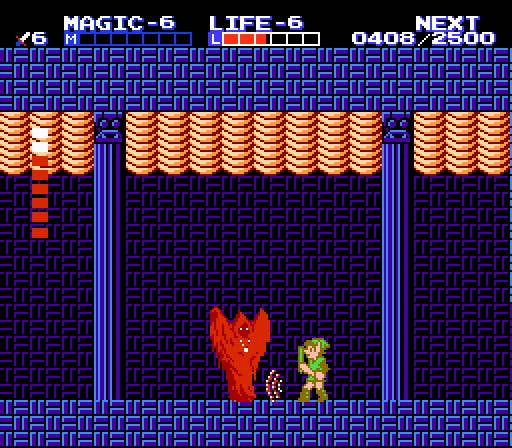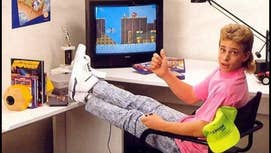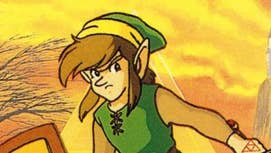Virtual Spotlight: Zelda II
Beneath its flawed surface, this ambitious 8-bit action RPG offers strengths worth reevaluating.
This article first appeared on USgamer, a partner publication of VG247. Some content, such as this article, has been migrated to VG247 for posterity after USgamer's closure - but it has not been edited or further vetted by the VG247 team.
People sure get angry about The Legend of Zelda: Skyward Sword, huh? But before that came along to become the Zelda fanbase's favorite punching bag (at least until the next game, at which point they'll hate that and retroactively declare Skyward Sword a work of genius), the least-beloved entry in the franchise was 1988's Zelda II: The Adventure of Link.
Playing it today on Wii U Virtual Console, you can certainly understand the frustration surrounding it. It's certainly not Zelda as you know it; in fact, Zelda II bears very little resemblance to any other chapter of the entire series. You can see echoes in its sequels -- the addition of a magic meter in A Link to the Past, the emphasis on swordplay and parrying in the post-Ocarina titles -- but as an experience, Zelda II resembles nothing else on NES. Even games that borrowed heavily from it didn't copy it directly. Infinity's The Battle of Olympus, for example, nakedly mimicked Zelda II's action sequences. But it abandoned the overhead view of the world map and the specifics of the RPG-style leveling system, even though their inclusion helped define Zelda II.

I replayed Zelda II for the first time in nearly 25 years a few months back to better understand the game, and I was surprised by what I found. While certainly rough and in need of considerable refinement, Zelda II possesses a fantastic core of inspiration and quality that makes it one of the most forward-thinking games of the 8-bit era. On a fundamental level, it simply approaches the question behind the original Zelda ("How do you combine action and role-playing elements in a single package") from a different direction. The first Zelda took the top-down perspective of RPGs like Ultima and stripped out the need to use menus to attack by removing the abstraction from combat; Zelda II, on the other hand, takes a pure action style and grafts RPG mechanics onto it.
A few games had already pioneered this style, such as Falcom's Dragon Slayer series and Namco's Dragon Buster, but Zelda II went a step further than the rest. It placed protagonist Link in an expansive world depicted as a zoomed-out map with RPG-style random(-ish) encounters, giving him towns to explore and dungeons to conquer. A Metroid-like progression system determines your advancement across continents and toward the end of the adventure as you collect new tools and powers to break down various obstructions standing in the way of the next landmark and, ultimately, the final dungeon.

Zelda II emphasized combat and skilled play far more than other similar games, which were frequently unforgiving and arbitrary in their design. Zelda II certainly isn't a cakewalk, but its physics and mechanics possess a certain solidity and consistency lacking in its contemporaries. This marks the only Zelda in which swordplay constitutes the entirety of Link's combat arsenal, save a handful of costly magic spells, and as such a great deal of time clearly went into fine-tuning the flow and feel of battle. Link attacks and defends on two levels (high and low), earns the ability to perform downward stabs and upward thrusts, and generally goes toe to toe with enemies in a fashion that wouldn't come into play again until Ocarina of Time a decade later.
This being one of those early, innovative games that was throwing all sorts of ideas at the wall to see what would stick, Zelda II often misses the mark. Certain enemies feel downright unfair thanks to their wall-like defenses or various abilities that let them slip through Link's guard. This is the only Zelda to give you a stock of lives and send you scurrying for 1UPs, and the penalty for running out of lives is to be flung all the way back to the palace where the game begins, no matter how far away you may happen to be at the moment you die. A certain element of randomness, including infinitely spawning enemies that drain not only health but experience points, can force you to rely on luck to survive. And let's not forget all the invisible or hidden objects you need to uncover to complete the game. It can be frustrating.
Nevertheless, Zelda II probably plays better now than it did at its debut. Not that the game itself has improved -- though Virtual Console's save states help immensely -- but rather most people's understanding of what its creators hoped to accomplish has. Certainly I have a better appreciation of its ambitions now than I did when I barely even knew what an RPG was. Give is a fair chance and may find yourself surprised by how much there is to like in Link's adolescent journey.
ConclusionIf any game in Nintendo's pantheon begs for a remake, it's Zelda II. But even without the benefit of modern design maturity made possible in part by what Nintendo attempted with this adventure, it still merits reinvestigation. Flawed, but quite excellent.










